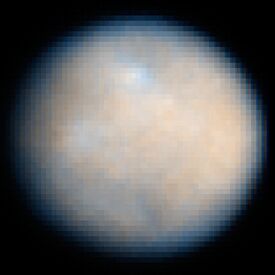Eliasb2011 (talk | contribs) (Adding categories) |
m (Reverted edits by Eliasb2011 (talk) to last version by Fett20) |
||
| (2 intermediate revisions by one other user not shown) | |||
| Line 18: | Line 18: | ||
[[Category:Ceres]] |
[[Category:Ceres]] |
||
[[Category:Planetoids]] |
[[Category:Planetoids]] |
||
| − | [[Category:Yellow objects]] |
||
| − | [[Category:Gray objects]] |
||
| − | [[Category:Article stubs]] |
||
| − | [[Category:Asteroids]] |
||
Revision as of 07:15, 12 June 2020
| Ceres | |
|---|---|

| |
| Diameter | :950 km |
Ceres, formal designation 1 Ceres, is the smallest identified dwarf planet in the Solar System and the only one in the asteroid belt. It was discovered on January 1, 1801, by Giuseppe Piazzi, and is named after the Roman goddess Ceres — the goddess of growing plants, the harvest, and motherly love. It was the first dwarf planet discovered.
With a diameter of about 950 km, Ceres is by far the largest and most massive body in the asteroid belt, and contains a third (32%) of the belt's total mass. Recent observations have revealed that it is spherical, unlike the irregular shapes of smaller bodies with lower gravity.The surface of Ceres is probably made of a mixture of water ice and various hydrated minerals like carbonates and clays. Ceres appears to be differentiated into a rocky core and ice mantle.[4] It may harbour an ocean of liquid water underneath its surface, which makes it a potential target in the search for extraterrestrial life.
Ceres' apparent magnitude ranges from 6.7 to 9.3, and hence at its brightest is still too dim to be seen with the naked eye.On September 27, 2007, NASA launched the Dawn space probe to explore Vesta (2011–2012) and Ceres in (2015).